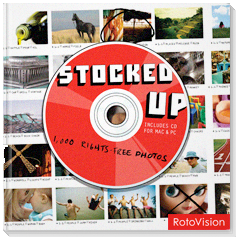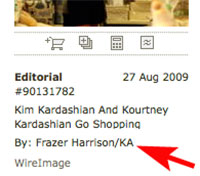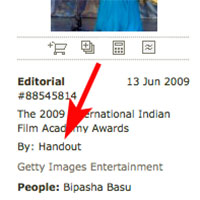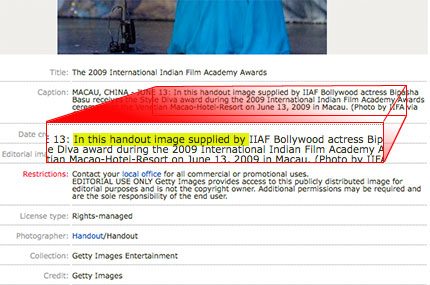iStockphoto Indemnifies Clients Up to $250k
iStockphoto has stepped up their efforts to woo wary would-be clients by indemnifying them in the event the client gets sued, according to this report by Cnet - iStockphoto seeks profit from others' legal worries - 9/15/09.
The free-wheeling days of free advertising photos being sourced from the likes of Flickr were brought back down to reality after the highly publicized case of Virgin Mobile being sued after they used a photograph of a young girl in their ads without a model release. ( MSNBC - Virgin Mobile sued over Flickr image used in ad, 9/20/07) Further complicating the matter, the photographer, who assigned a Creative Commons Attribution license, sued Creative Commons, because, as this article points out (Flickr User Sues Creative Commons Over License, 10/4/07) "According to the photographer, he didn't realize that by licensing his photos Attribution Only, he was agreeing to commercial uses like advertising....they [Creative Commons] were explicitly targeting non-legally-sophisticated users (i.e., separating their licenses into Human Readable and Legalese) and urging them to use CC's form licenses." The Virgin Mobile case is just one of many lawsuits that have caused a chilling effect for major corporations' willingness to use Flickr/et al images to save a few dollars on the front end only to be hit with big dollar settlement amounts in the end. The AP/Shepard Fairey case (The Associated Press v. Shepard Fairey, 2/4/09), is among others.
In one report on a now locked iStockphoto forum thread by Craig Swatton reveals "I was speaking to someone who works in London for a major global firm and on my suggestion they were going to come here for images to put into a presentation but it turns out the firm's global policy explicitly bans istock (along with one of the other main competitor)."
In the iStockPhoto licensing agreement, as of September 15, 2009, it states, in part:
7. Limited Representations and Warranties(a) The Site acts as an exchange of Content between those who provide Content to the Site and those who wish to use such Content. iStockphoto grants no rights and makes no warranties regarding the use of names, people, trademarks, trade dress, patented or copyrighted designs or works of art or architecture or other forms of intellectual property represented in any Content. While we have made reasonable efforts to correctly categorize and keyword the Content, iStockphoto does not warrant the accuracy of such information.9. Indemnification
(b) THE CONTENT IS PROVIDED “AS IS” WITHOUT REPESENTATION, WARRANTY OR CONDITION OF ANY KIND, EITHER EXPRESS OR IMPLIED, INCLUDING, BUT NOT LIMITED TO THE IMPLIED REPRESENTATIONS, WARRANTIES OR CONDITIONS OF MERCHANTABILITY, OR FITNESS FOR A PARTICULAR PURPOSE. ISTOCKPHOTO DOES NOT REPRESENT OR WARRANT THAT THE CONTENT WILL MEET YOUR REQUIREMENTS OR THAT ITS USE WILL BE UNINTERRUPTED OR ERROR FREE. THE ENTIRE RISK AS TO THE QUALITY AND PERFORMANCE OF THE CONTENT IS WITH YOU. SHOULD THE CONTENT PROVE DEFECTIVE, YOU (AND NOT ISTOCKPHOTO) ASSUME THE ENTIRE RISK AND COST OF ALL NECESSARY CORRECTIONS.
IN PARTICULAR AND WITHOUT LIMITING THE GENERALITY OF THE FOREGOING, IF YOU ARE DOWNLOADING CONTENT THAT IS IN A FLASH FORMAT OR FILE (WHETHER .SWF OR OTHERWISE) ISTOCKPHOTO MAKES NO REPRESENTATION OR WARRANTY RESPECTING SUCH CONTENT WHATSOEVER, WHETHER AS TO OWNERSHIP, TECHNICAL OR LEGAL COMPLIANCE, OR OTHERWISE.You agree to indemnify, defend and hold iStockphoto, its affiliates, its Content providers and their respective directors, officers, employees, shareholders, partners and agents (collectively, the “iStockphoto Parties”) harmless from and against any and all claims, liability, losses, damages, costs and expenses (including reasonable legal fees on a solicitor and client basis) incurred by any iStockphoto Party as a result of or in connection with any breach by you or anyone acting on your behalf of any of the terms of this Agreement.
Clearly, some actuary did the math and concluded that the likelihood of an image being used and then a lawsuit being brought was sufficient that they could include, as a part of your $1.00 license to use a photo, atleast $10,000 in insurance, and as much as $250,000 if you are a frequent user of iStockphoto. Likely, iStockphoto is not self-insuring against this, but rather has a specific policy to protect them in these cases.
Interesting, since the v1.2(d) edition of the Flickr/Getty contract, clause 5 says that the contributor:
"Each party represents and warrants to each other that it has the full power, authority, legal capacity and is of sufficient age to enter into the Agreement and perform its obligations hereunder...content will not infringe the copyright of any third party, and will not contain any subject matter which violates any applicable law or regulation and, if released, will not defame, violate the right of privacy or publicity, or infringe the trademark or other personal or property interests of the parties..."The contract goes on, stipulating that
"Each Party (an "indemnitor") agrees to defend, indemnify, and hold harmless the other Party..." and then goes on "Getty Images shall not be liable for any punitive...damages...you shall bear sole responsibility for obtaining and maintaining adequate insurance for protection of Content. If, despite the above limitations, liability is imposed on Getty Images for any of these reasons, in not event shall Getty Images' liability exceed US$10,000 in the aggregate."Thus, iStockphoto/Getty/et al are protected because once the end client says "hey, I just got sued for using one of your photos..." Getty will offer to settle up to $250k, and then, in turn, has every right to sue the hobbiest/soccer mom/amateur for whatever they had to spend, plus all their attributable legal fees for handling this. These issues will also likely be reasons for photos getting rejected because of trademarks in the content.
As more lawsuits are filed from Flickr/Creative Commons/Royalty-Free uses of photography, those willing to spend high dollars for pictures will continue to turn away more and more from the penny-stocks, with these tens of millions of images being relegated to school reports and uninformed mom-and-pop shops who don't know what they are - and are not - getting. Atleast they're getting insurance, for the time being.
Please post your comments by clicking the link below. If you've got questions, please pose them in our Photo Business Forum Flickr Group Discussion Threads.









